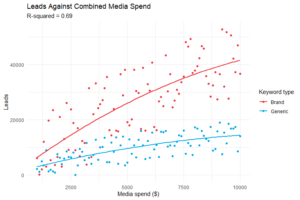
Unleash the true value of your data with our center of excellence, Proove Intelligence.

Good news: You’ve decided to abandon last-click attribution measurement and made a firm resolution this year to step up your media attribution analysis game. Was losing third-party cookies and your ability to measure channel performance the reason?
Or, you’re just think it’s time to change the way you’re evaluating upper funnel media, then media mix modeling can be a solution. Why? The primary reason being that it can report on performance without the same requirements for impression and click-based journey tracking.
It is indeed a 50-year-old practice based on the two following principles:
In short, media mix modeling focuses on understanding the relative contributions of different channels, or different funnel stages of activity, on performance of a media campaign.
Media mix modeling can provide insight into base and incremental conversions and revenue. Simply put, incremental results are the percentage of media-touched conversions that would not have occurred without marketing exposure. The analysis of base and incremental results can reveal the underlying brand awareness and loyalty over the long term, as well as the effect of shorter-term advertising activities and competition levels.
Traditionally, established statistical techniques such as linear regression analysis have been used to perform these calculations, but more sophisticated tools are emerging to take media mix modeling to the next level.
Since the 1960s, statisticians have patiently performed media mix modeling analyses using traditional econometric tools such as linear regression, sometimes even by hand. But media data have become more complex over the years, and the shortcomings of traditional methods have become increasingly apparent. Similarly, media data has become increasingly available and granular, with the multiplication of first-party data enriched by second- and third-party data. Finally, the computing power of machines having been overmultiplied and all the conditions were met to allow new machine learning methods to be applied in the framework of media mix modeling analysis.
Some of these approaches, such as Robyn—Meta’s ML-powered and semi-automated marketing mix modeling open source package launched back in 2021—seek to simplify the technique, allowing users to “pour” their cost and conversion data into a data science workflow and generate a selection of models. In short, machine learning simplifies the process: It is able to iteratively and rapidly tweak the model for better performance.
Did you really think we were going to tell you that a simple (or not so simple!) machine would do the job perfectly?
Even if it is technically possible to simply put the data into the machine and cross your fingers that everything goes well, we are convinced of the importance of the strategic contribution of data scientists, statisticians, and subject matter experts to develop a truly relevant and efficient model.
Here are some situations where deeper investigation would be more than welcomed:
Let’s explore this last case in a little more depth. For example, you could have decided to include “paid search” as a single channel in your analysis. This seems like a logical thing to do, but within each channel there may exist different behaviors of the data, and these vastly different patterns may limit the accuracy of the model:

Exploring the data before the model build may uncover these differences, such as between branded keywords and generic keywords campaigns or variation of performance between regions, which can inform the model building process and improve model accuracy:

The myopia caused by hidden patterns in the concatenated data can lead to questionable decisions that result in unnecessary risk-taking and potential disastrous consequences on campaign profitability.
Subscribe to our monthly newsletter.
Among the potential negative impact of over-reliance on machine learning media mix modeling tactics, you could for example end up setting your budget splits completely inappropriately, overinvesting in irrelevant channels or underfunding others. You could also end up with a model output that is incorrectly interpreted—that would be the case if you are provided with an aggregate model for the whole year but are in fact in a highly seasonal business.
The solution? Common sense, first and foremost. Asking yourself if what the model presents to us makes intuitive sense, based on your knowledge of the industry, the company, its products, its past successes.
And the second option, complementary to the first: The implementation of a robust process of testing and experimentation, to give yourself the opportunity to explore all scenarios, even the most unexpected, in a controlled environment.
Is media mix modeling version 2023 for every company and every industry? Well, it is for you if:
We hope that this first excursion into the fascinating world of media mix modeling has helped you ask yourself the right questions. Do not hesitate to contact our experts to see if this technique is the best option for your company.
Unleash the true value of your data with our center of excellence, Proove Intelligence.
Unleash the true value of your data with our center of excellence, Proove Intelligence.
Unleash the true value of your data with our center of excellence, Proove Intelligence.
Subscribe to our monthly newsletter.